engine overheat INFINITI QX50 2021 Owner's Manual
[x] Cancel search | Manufacturer: INFINITI, Model Year: 2021, Model line: QX50, Model: INFINITI QX50 2021Pages: 542, PDF Size: 3.51 MB
Page 90 of 542

TACHOMETER
The tachometer indicates engine speed in
revolutions per minute (rpm). Do not rev the
engine into the red zone
O1.
CAUTION
When engine speed approaches the red
zone, reduce engine speed. Operating the
engine in the red zone may cause serious
engine damage.
ENGINE COOLANT
TEMPERATURE GAUGE
The gauge indicates the engine coolant tem-
perature. The engine coolant temperature is
within the normal range
O1when the gauge
needle points within the zone shown in the
illustration.
The engine coolant temperature varies with
the outside air temperature and driving
conditions.
CAUTION
If the gauge indicates coolant temperature
near the hot (H) end of the normal range,
reduce vehicle speed to decrease tempera-
ture. If the gauge is over the normal range,
stop the vehicle as soon as safely possible.
If the engine is overheated, continued op-
eration of the vehicle may seriously dam-
age the engine. For additional information,
see “If your vehicle overheats” (P. 6-7) for
immediate action required.
LIC3849LIC3850
2-6Instruments and controls
Page 127 of 542

CAUTION
• The battery could run down if the climate
control seat is operated while the engine
is not running.
• Do not use the climate control seat for
extended periods or when no one is using
the seat.
• Do not put anything on the seat which
insulates heat, such as a blanket, cush-
ion, seat cover, etc. Otherwise, the seat
may become overheated.
• Do not place anything hard or heavy on
the seat or pierce it with a pin or similar
objects. This may result in damage to the
climate controlled seat.
• Any liquid spilled on the seat should be
removed immediately with a dry cloth.
• When cleaning the seat, never use gaso-
line, benzine, thinner, or any similar
materials.
• If any malfunctions are found or the cli-
mate controlled seat does not operate,
turn the switch off and have the system
checked. It is recommended that you
visit an INFINITI retailer for this service. The climate controlled seat cools down the
front seat by blowing cool air from under the
surface of the seat. The climate control
switch is located on the center console.
The climate controlled seat can be operated
as follows:
1. Place the ignition switch in the ON
position.
2. Push the climate controlled seat switches to cool the seat. The indicator light on the
corresponding switch will illuminate.
3. Adjust the desired amount of air by push- ing the switch again. The climate con-
trolled seat blower remains on low speed
for approximately 60 seconds after push-
ing the switch on.
4. When the vehicle's interior is warmed or cooled, or before you leave the vehicle, be
sure to turn off the climate controlled
seats. To turn off the climate controlled
seats, push the switch until the indicator
light does not illuminate.
WARNING
Do not use or allow occupants to use the
seat heater if you or the occupants cannot
monitor elevated seat temperatures or
have an inability to feel pain in body parts
that contact the seat. Use of the seat
heater by such people could result in seri-
ous injury.
LIC3906
HEATED SEATS (if so equipped)
Instruments and controls2-43
Page 128 of 542

CAUTION
• The battery could run down if the seat
heater is operated while the engine is not
running.
• Do not use the seat heater for extended
periods or when no one is using the seat.
• Do not put anything on the seat which
insulates heat, such as a blanket, cush-
ion, seat cover, etc. Otherwise, the seat
may become overheated.
• Do not place anything hard or heavy on
the seat or pierce it with a pin or similar
object. This may result in damage to the
heater. •
Any liquid spilled on the heated seat
should be removed immediately with a
dry cloth.
• When cleaning the seat, never use gaso-
line, benzine, thinner, or any similar
materials.
• If any malfunctions are found or the
heated seat does not operate, turn the
switch off and have the system checked.
It is recommended that you visit an
INFINITI retailer for this service.
Switch operation:
The front seats are warmed by built-in heat-
ers. The switches are located on the center
console and can be operated independently
of each other.
1. Place the ignition switch in the ON position.
2. Push the heated seat switch and select the desired heat range.
• For high heat, push the switch once.
• For medium heat, push the switch twice.
• For low heat, push the switch three times.
• The indicator light will illuminate when the heater is on. 3. To turn off the heater, push the heated
seat switch again. Make sure that the in-
dicator light turns off.
The heater is controlled by a control mod-
ule, automatically turning the heater on
and off.
The indicator light will remain on as long
as the switch is on.
When the seat is warmed, or before you
leave the vehicle, be sure to turn the
switch off.
Touch screen operation:
• Touch the
key on the lower display.
Select an item from High, Mid, Low, or
OFF.
NOTE:
For additional information, see “Heater and
air conditioner (automatic)” (P. 4-34).
LHA5300
2-44Instruments and controls
Page 247 of 542
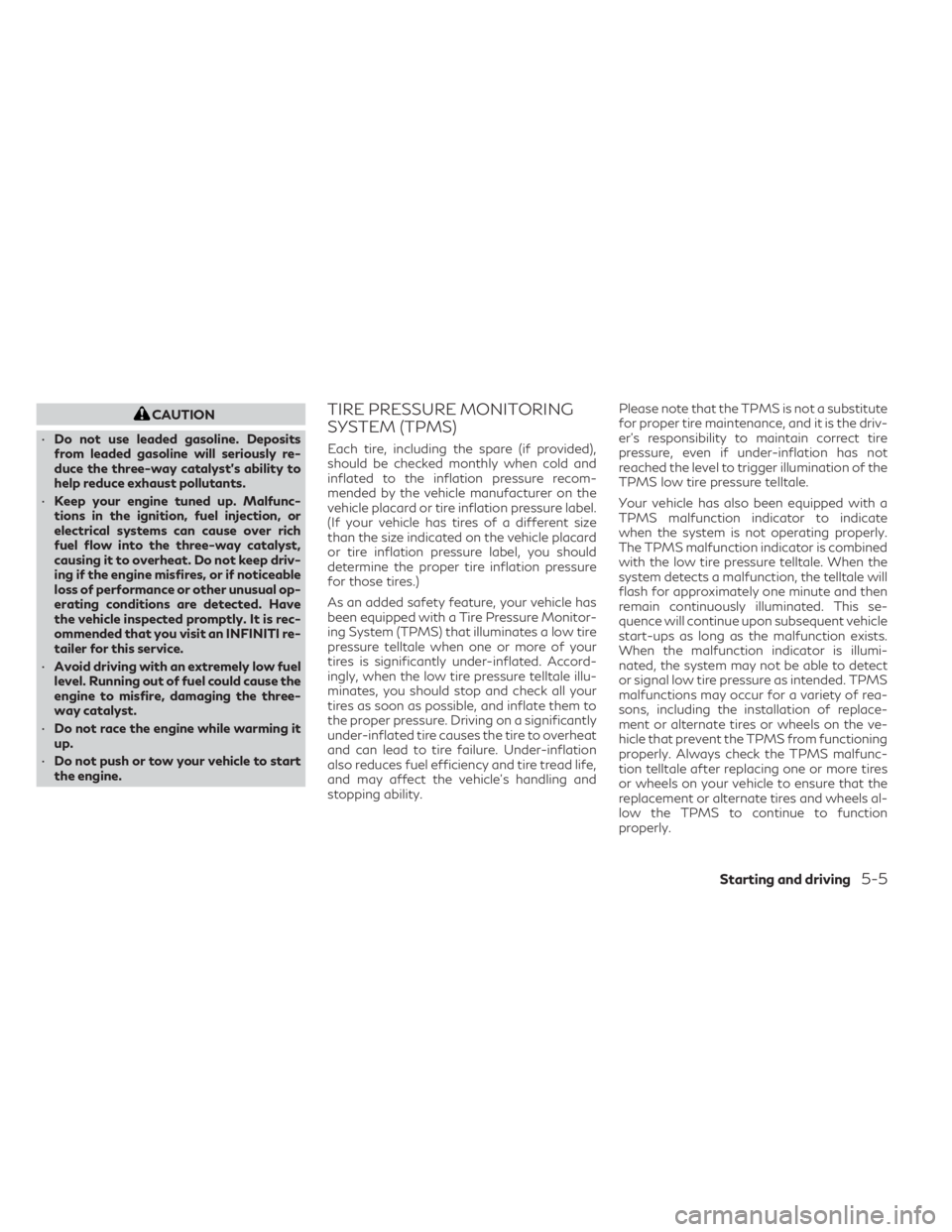
CAUTION
• Do not use leaded gasoline. Deposits
from leaded gasoline will seriously re-
duce the three-way catalyst's ability to
help reduce exhaust pollutants.
• Keep your engine tuned up. Malfunc-
tions in the ignition, fuel injection, or
electrical systems can cause over rich
fuel flow into the three-way catalyst,
causing it to overheat. Do not keep driv-
ing if the engine misfires, or if noticeable
loss of performance or other unusual op-
erating conditions are detected. Have
the vehicle inspected promptly. It is rec-
ommended that you visit an INFINITI re-
tailer for this service.
• Avoid driving with an extremely low fuel
level. Running out of fuel could cause the
engine to misfire, damaging the three-
way catalyst.
• Do not race the engine while warming it
up.
• Do not push or tow your vehicle to start
the engine.TIRE PRESSURE MONITORING
SYSTEM (TPMS)
Each tire, including the spare (if provided),
should be checked monthly when cold and
inflated to the inflation pressure recom-
mended by the vehicle manufacturer on the
vehicle placard or tire inflation pressure label.
(If your vehicle has tires of a different size
than the size indicated on the vehicle placard
or tire inflation pressure label, you should
determine the proper tire inflation pressure
for those tires.)
As an added safety feature, your vehicle has
been equipped with a Tire Pressure Monitor-
ing System (TPMS) that illuminates a low tire
pressure telltale when one or more of your
tires is significantly under-inflated. Accord-
ingly, when the low tire pressure telltale illu-
minates, you should stop and check all your
tires as soon as possible, and inflate them to
the proper pressure. Driving on a significantly
under-inflated tire causes the tire to overheat
and can lead to tire failure. Under-inflation
also reduces fuel efficiency and tire tread life,
and may affect the vehicle’s handling and
stopping ability. Please note that the TPMS is not a substitute
for proper tire maintenance, and it is the driv-
er’s responsibility to maintain correct tire
pressure, even if under-inflation has not
reached the level to trigger illumination of the
TPMS low tire pressure telltale.
Your vehicle has also been equipped with a
TPMS malfunction indicator to indicate
when the system is not operating properly.
The TPMS malfunction indicator is combined
with the low tire pressure telltale. When the
system detects a malfunction, the telltale will
flash for approximately one minute and then
remain continuously illuminated. This se-
quence will continue upon subsequent vehicle
start-ups as long as the malfunction exists.
When the malfunction indicator is illumi-
nated, the system may not be able to detect
or signal low tire pressure as intended. TPMS
malfunctions may occur for a variety of rea-
sons, including the installation of replace-
ment or alternate tires or wheels on the ve-
hicle that prevent the TPMS from functioning
properly. Always check the TPMS malfunc-
tion telltale after replacing one or more tires
or wheels on your vehicle to ensure that the
replacement or alternate tires and wheels al-
low the TPMS to continue to function
properly.
Starting and driving5-5
Page 253 of 542
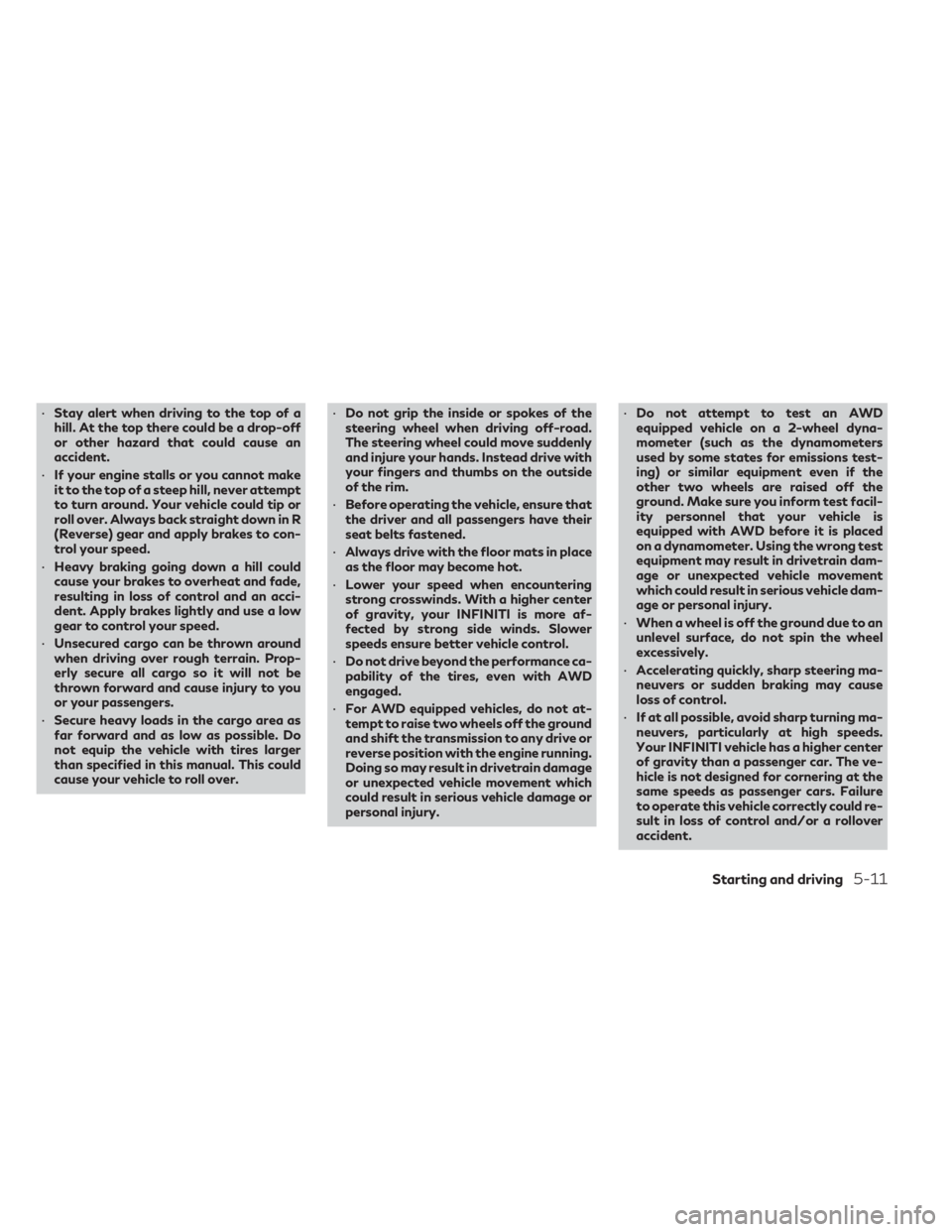
•Stay alert when driving to the top of a
hill. At the top there could be a drop-off
or other hazard that could cause an
accident.
• If your engine stalls or you cannot make
it to the top of a steep hill, never attempt
to turn around. Your vehicle could tip or
roll over. Always back straight down in R
(Reverse) gear and apply brakes to con-
trol your speed.
• Heavy braking going down a hill could
cause your brakes to overheat and fade,
resulting in loss of control and an acci-
dent. Apply brakes lightly and use a low
gear to control your speed.
• Unsecured cargo can be thrown around
when driving over rough terrain. Prop-
erly secure all cargo so it will not be
thrown forward and cause injury to you
or your passengers.
• Secure heavy loads in the cargo area as
far forward and as low as possible. Do
not equip the vehicle with tires larger
than specified in this manual. This could
cause your vehicle to roll over. •
Do not grip the inside or spokes of the
steering wheel when driving off-road.
The steering wheel could move suddenly
and injure your hands. Instead drive with
your fingers and thumbs on the outside
of the rim.
• Before operating the vehicle, ensure that
the driver and all passengers have their
seat belts fastened.
• Always drive with the floor mats in place
as the floor may become hot.
• Lower your speed when encountering
strong crosswinds. With a higher center
of gravity, your INFINITI is more af-
fected by strong side winds. Slower
speeds ensure better vehicle control.
• Do not drive beyond the performance ca-
pability of the tires, even with AWD
engaged.
• For AWD equipped vehicles, do not at-
tempt to raise two wheels off the ground
and shift the transmission to any drive or
reverse position with the engine running.
Doing so may result in drivetrain damage
or unexpected vehicle movement which
could result in serious vehicle damage or
personal injury. •
Do not attempt to test an AWD
equipped vehicle on a 2-wheel dyna-
mometer (such as the dynamometers
used by some states for emissions test-
ing) or similar equipment even if the
other two wheels are raised off the
ground. Make sure you inform test facil-
ity personnel that your vehicle is
equipped with AWD before it is placed
on a dynamometer. Using the wrong test
equipment may result in drivetrain dam-
age or unexpected vehicle movement
which could result in serious vehicle dam-
age or personal injury.
• When a wheel is off the ground due to an
unlevel surface, do not spin the wheel
excessively.
• Accelerating quickly, sharp steering ma-
neuvers or sudden braking may cause
loss of control.
• If at all possible, avoid sharp turning ma-
neuvers, particularly at high speeds.
Your INFINITI vehicle has a higher center
of gravity than a passenger car. The ve-
hicle is not designed for cornering at the
same speeds as passenger cars. Failure
to operate this vehicle correctly could re-
sult in loss of control and/or a rollover
accident.
Starting and driving5-11
Page 267 of 542
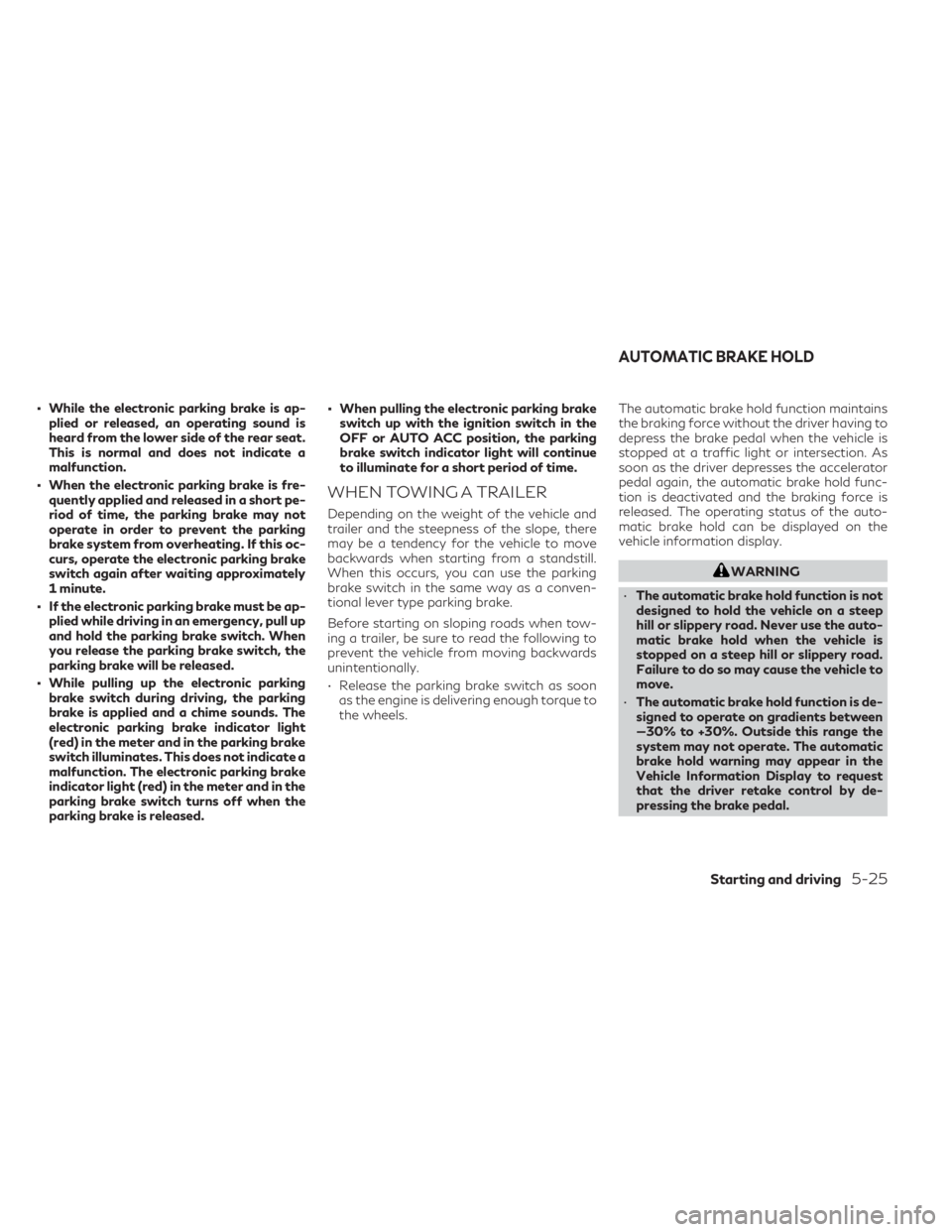
• While the electronic parking brake is ap-plied or released, an operating sound is
heard from the lower side of the rear seat.
This is normal and does not indicate a
malfunction.
• When the electronic parking brake is fre- quently applied and released in a short pe-
riod of time, the parking brake may not
operate in order to prevent the parking
brake system from overheating. If this oc-
curs, operate the electronic parking brake
switch again after waiting approximately
1 minute.
• If the electronic parking brake must be ap- plied while driving in an emergency, pull up
and hold the parking brake switch. When
you release the parking brake switch, the
parking brake will be released.
• While pulling up the electronic parking brake switch during driving, the parking
brake is applied and a chime sounds. The
electronic parking brake indicator light
(red) in the meter and in the parking brake
switch illuminates. This does not indicate a
malfunction. The electronic parking brake
indicator light (red) in the meter and in the
parking brake switch turns off when the
parking brake is released. • When pulling the electronic parking brake
switch up with the ignition switch in the
OFF or AUTO ACC position, the parking
brake switch indicator light will continue
to illuminate for a short period of time.
WHEN TOWING A TRAILER
Depending on the weight of the vehicle and
trailer and the steepness of the slope, there
may be a tendency for the vehicle to move
backwards when starting from a standstill.
When this occurs, you can use the parking
brake switch in the same way as a conven-
tional lever type parking brake.
Before starting on sloping roads when tow-
ing a trailer, be sure to read the following to
prevent the vehicle from moving backwards
unintentionally.
• Release the parking brake switch as soonas the engine is delivering enough torque to
the wheels. The automatic brake hold function maintains
the braking force without the driver having to
depress the brake pedal when the vehicle is
stopped at a traffic light or intersection. As
soon as the driver depresses the accelerator
pedal again, the automatic brake hold func-
tion is deactivated and the braking force is
released. The operating status of the auto-
matic brake hold can be displayed on the
vehicle information display.
WARNING
• The automatic brake hold function is not
designed to hold the vehicle on a steep
hill or slippery road. Never use the auto-
matic brake hold when the vehicle is
stopped on a steep hill or slippery road.
Failure to do so may cause the vehicle to
move.
• The automatic brake hold function is de-
signed to operate on gradients between
—30% to +30%. Outside this range the
system may not operate. The automatic
brake hold warning may appear in the
Vehicle Information Display to request
that the driver retake control by de-
pressing the brake pedal.
AUTOMATIC BRAKE HOLD
Starting and driving5-25
Page 391 of 542
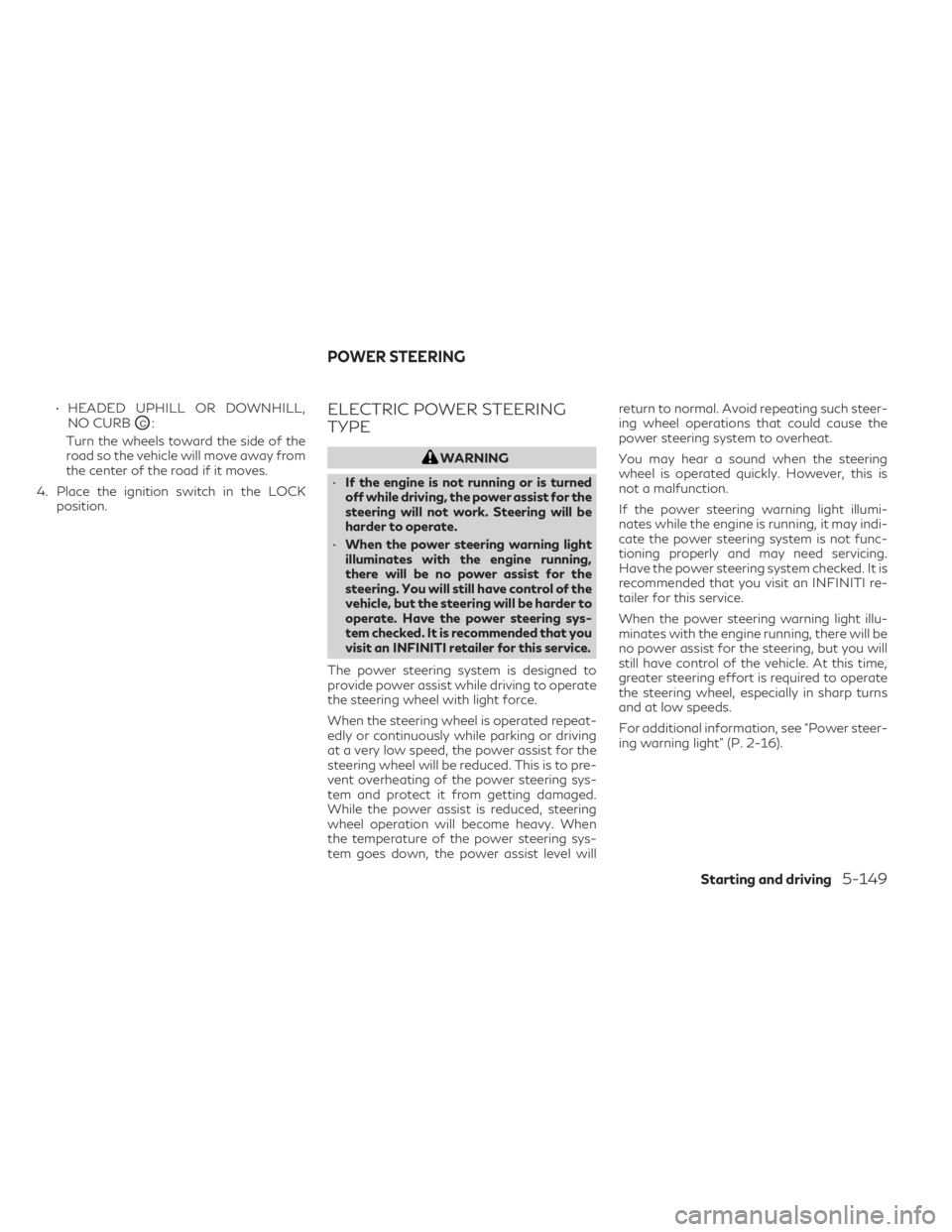
• HEADED UPHILL OR DOWNHILL,NO CURB
OC:
Turn the wheels toward the side of the
road so the vehicle will move away from
the center of the road if it moves.
4. Place the ignition switch in the LOCK position.ELECTRIC POWER STEERING
TYPE
WARNING
• If the engine is not running or is turned
off while driving, the power assist for the
steering will not work. Steering will be
harder to operate.
• When the power steering warning light
illuminates with the engine running,
there will be no power assist for the
steering. You will still have control of the
vehicle, but the steering will be harder to
operate. Have the power steering sys-
tem checked. It is recommended that you
visit an INFINITI retailer for this service.
The power steering system is designed to
provide power assist while driving to operate
the steering wheel with light force.
When the steering wheel is operated repeat-
edly or continuously while parking or driving
at a very low speed, the power assist for the
steering wheel will be reduced. This is to pre-
vent overheating of the power steering sys-
tem and protect it from getting damaged.
While the power assist is reduced, steering
wheel operation will become heavy. When
the temperature of the power steering sys-
tem goes down, the power assist level will return to normal. Avoid repeating such steer-
ing wheel operations that could cause the
power steering system to overheat.
You may hear a sound when the steering
wheel is operated quickly. However, this is
not a malfunction.
If the power steering warning light illumi-
nates while the engine is running, it may indi-
cate the power steering system is not func-
tioning properly and may need servicing.
Have the power steering system checked. It is
recommended that you visit an INFINITI re-
tailer for this service.
When the power steering warning light illu-
minates with the engine running, there will be
no power assist for the steering, but you will
still have control of the vehicle. At this time,
greater steering effort is required to operate
the steering wheel, especially in sharp turns
and at low speeds.
For additional information, see “Power steer-
ing warning light” (P. 2-16).
POWER STEERING
Starting and driving5-149
Page 393 of 542

steering wheel will return to the normal posi-
tion after the protection mechanism is
deactivated.
Condition A:
• When the engine is stalled or likely to bestalled
• When the steering wheel is held in the full lock position or when the front tire touches
an obstruction
• When the battery is discharged
To return the steering wheel to the normal
position, stop the vehicle in a safe location
and stop operating the steering wheel. Then
drive the vehicle for a short period of time.
Condition B:
• When the steering wheel is operated re- peatedly or continuously while parking or
driving at a very low speed. In this case, the
power assist for the steering wheel will be
reduced.
To return the steering wheel to the normal
position, stop the vehicle in a safe location
and wait for a period of time, without oper-
ating the steering wheel, until the tempera-
ture of Direct Adaptive Steering cools down.
Avoid repeated steering wheel operations
that could cause Direct Adaptive Steering to
overheat. When the vehicle is tested on the 2–wheel
dynamometer, the power steering warning
light may illuminate. To turn off the power
steering warning light, stop the vehicle in a
safe location, turn the engine off, restart the
engine, and then drive the vehicle for a period
of time.
The following conditions do not indicate a
malfunction of Direct Adaptive Steering:
• You may notice wider steering play when
the ignition switch is in the OFF or AUTO
ACC position compared to when it is in the
ON position.
• After the engine is started, the steering wheel may turn slightly even when driving a
straight road. To return to the normal posi-
tion, drive the vehicle on a straight road for
a period of time.
• After the engine is started, the steering wheel may move if the steering wheel was
turned to the fully locked position while the
ignition switch was in the OFF position.
• After the vehicle is tested on the 4–wheel dynamometer, the steering wheel may turn
slightly even when driving on a straight
road. To return the steering wheel to the
normal position, drive the vehicle on a
straight road for a period of time. You may hear a noise under the following
conditions. However, this is not a malfunc-
tion.
• When the engine is started or stopped.
• When the steering wheel is turned in the full
lock position.
Starting and driving5-151
Page 394 of 542
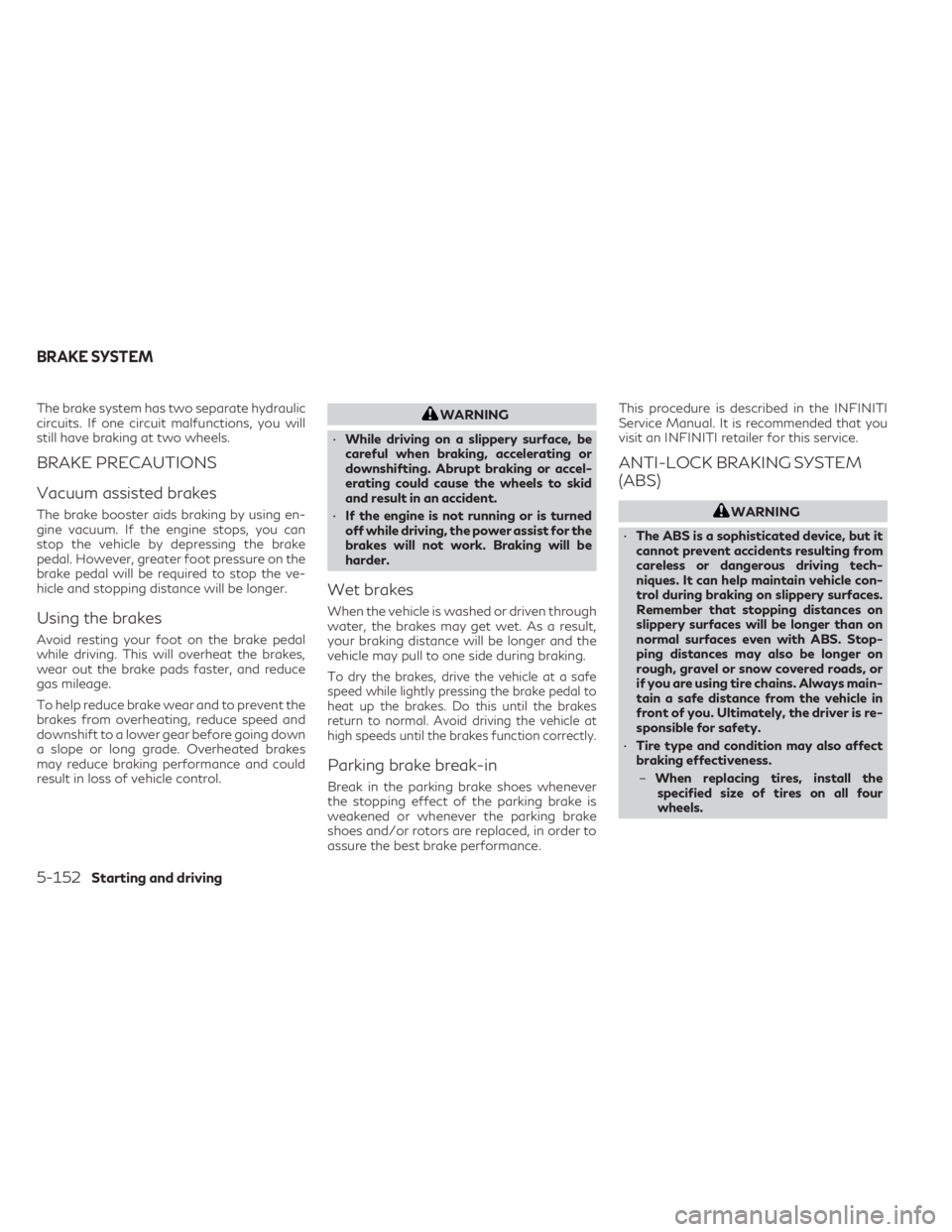
The brake system has two separate hydraulic
circuits. If one circuit malfunctions, you will
still have braking at two wheels.
BRAKE PRECAUTIONS
Vacuum assisted brakes
The brake booster aids braking by using en-
gine vacuum. If the engine stops, you can
stop the vehicle by depressing the brake
pedal. However, greater foot pressure on the
brake pedal will be required to stop the ve-
hicle and stopping distance will be longer.
Using the brakes
Avoid resting your foot on the brake pedal
while driving. This will overheat the brakes,
wear out the brake pads faster, and reduce
gas mileage.
To help reduce brake wear and to prevent the
brakes from overheating, reduce speed and
downshift to a lower gear before going down
a slope or long grade. Overheated brakes
may reduce braking performance and could
result in loss of vehicle control.
WARNING
• While driving on a slippery surface, be
careful when braking, accelerating or
downshifting. Abrupt braking or accel-
erating could cause the wheels to skid
and result in an accident.
• If the engine is not running or is turned
off while driving, the power assist for the
brakes will not work. Braking will be
harder.
Wet brakes
When the vehicle is washed or driven through
water, the brakes may get wet. As a result,
your braking distance will be longer and the
vehicle may pull to one side during braking.
To dry the brakes, drive the vehicle at a safe
speed while lightly pressing the brake pedal to
heat up the brakes. Do this until the brakes
return to normal. Avoid driving the vehicle at
high speeds until the brakes function correctly.
Parking brake break-in
Break in the parking brake shoes whenever
the stopping effect of the parking brake is
weakened or whenever the parking brake
shoes and/or rotors are replaced, in order to
assure the best brake performance. This procedure is described in the INFINITI
Service Manual. It is recommended that you
visit an INFINITI retailer for this service.
ANTI-LOCK BRAKING SYSTEM
(ABS)
WARNING
• The ABS is a sophisticated device, but it
cannot prevent accidents resulting from
careless or dangerous driving tech-
niques. It can help maintain vehicle con-
trol during braking on slippery surfaces.
Remember that stopping distances on
slippery surfaces will be longer than on
normal surfaces even with ABS. Stop-
ping distances may also be longer on
rough, gravel or snow covered roads, or
if you are using tire chains. Always main-
tain a safe distance from the vehicle in
front of you. Ultimately, the driver is re-
sponsible for safety.
• Tire type and condition may also affect
braking effectiveness.
– When replacing tires, install the
specified size of tires on all four
wheels.
BRAKE SYSTEM
5-152Starting and driving
Page 411 of 542

6 In case of emergency
Hazard warning flasher switch...................6-2
Roadside assistance program .....................6-2
Emergency engine shut off .......................6-3
Flat tire ..........................................6-3
Tire Pressure Monitoring System (TPMS) ......6-3
Run-flat tires .................................6-4 Jump starting
....................................6-5
Push starting ....................................6-7
If your vehicle overheats .........................6-7
Towing your vehicle ..............................6-8
Towing recommended by INFINITI ............6-8
Vehicle recovery (freeing a stuck vehicle) ......6-11